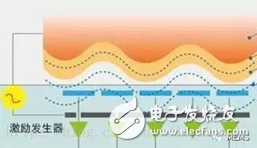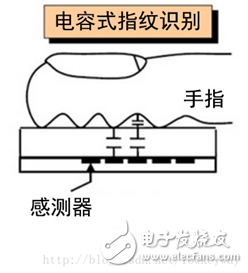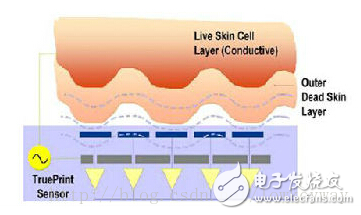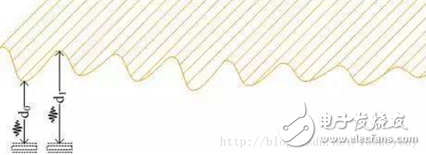After we learned about the general process of fingerprinting, this article is used to introduce the most important part of fingerprint recognition hardware, sensors. In fact, sensors and chips must also conform to the basic principles of physics. They are all realizations of the principles of physics. We can start from the basic physics research fields of light, electricity, sound, heat and power. The classification and implementation of mainstream fingerprint recognition sensors today.
First, the optical sensorThe history of optical sensors is probably the longest, and it has been 30 years old. The principle of implementation is also the simplest. It mainly uses the principle of folding and reflection of light to place the finger on the optical lens. Under the illumination of the built-in light source, the light is directed from the bottom to the prism, and is emitted through the prism. The emitted light is on the surface of the finger surface. The angle of refraction on the grain and the brightness of the reflected light will be different. Projecting it onto a CMOS or CCD on a charge-coupled device with a prism, thereby forming a ridge line (a line with a certain width and direction in the fingerprint image) that is black, and the valley line (the recessed portion between the lines) is white. A multi-gray fingerprint image that can be processed by a fingerprint device algorithm.

figure 1
The advantages of optical fingerprint sensors are mainly as follows:
1. Strong antistatic ability, good system stability and long service life
2. Sensitivity is particularly high
3. Provides high resolution fingerprint images (up to 500 dpi).
The disadvantages are also obvious:
1, potential fingerprints (multiple presses), will reduce the quality of fingerprint images
2. The platen coating and CCD array will produce loss over time, which may result in the degradation of the collected fingerprint image quality.
3, the volume is relatively large, power control is not good
use:
In view of the relatively large volume of optical sensors, its application fields mainly focus on fingerprint door locks, safes, and car fingerprint anti-theft.
development of:
Optical sensors still have a large market share in the traditional industry where volume and power consumption requirements are not critical, but they are lost in the big market of mobile terminals such as mobile phones.
At the end of 16th, SynapTIcs released the new optical sensor FS9100, which mainly focuses on the penetration of optical sensors (can penetrate a glass of about 1mm), and the target is underglass. And with the general trend of fingerprint recognition in In Display screens, optical sensors will inevitably come back with new technology.
Second, the capacitive sensorCapacitive sensors should be the most popular mobile phones and portable terminal devices. Of course, the existence is reasonable. Since capacitive sensors occupy such a large market, what advantages does it have?
The principle is to integrate the capacitive sense into a chip. When the fingerprint presses the surface of the chip, the internal capacitive sensor generates a fingerprint image according to the difference in charge generated by the peaks and troughs of the fingerprint. As shown in the following diagram, the upper bump can be regarded as the valley and ridge of the fingerprint, so the sensor will form different capacitance differences, so that the sensor can draw the texture of the fingerprint according to these different capacitance differences.

Capacitive sensors are divided into active and passive, we can refer to the following two figures.
Active:
The principle is mainly to load the finger on the finger by the applied driving signal (such as Ring) to enhance the electric charge on the surface of the finger, so that the underlying sensing array receives the electric field signal and amplifies the signal, and the electric field induced by the chip is inconsistent according to the unevenness of the fingerprint. Reproduce the fingerprint (as shown below):
Write a picture description here

passive
The working principle is different; when the finger is pressed on the surface of the chip, the peak wave trough of the fingerprint affects the ratio of the charge distribution of the upper and lower electrodes of the chip to reproduce the fingerprint, without additional driving source, the chip structure is very simple. (As shown below), because there is no extra drive signal, the module does not need external Ring, and the module structure is very simple.
Write a picture description here

The principle of active and passive is also well distinguished, and the active type is an additional excitation power supply. It can be imagined that the active capacitive sensor penetration will be stronger, but it will bring more noise, so whether it is an active or passive sensor is not good, it depends on the technology.
advantage:
1, chips and modules can be made very thin
2, power consumption is easier to control
Disadvantages:
1, the penetration rate is relatively low
2, the price is relatively high
3, waterproof, anti-fouling is not strong
development of:
Capacitive sensors are by far the most common use. However, it is seen that the fingerprint recognition should be developed in the direction of fingerprint recognition in the screen, and the capacitive transmittance is about 200 um. The basic glass cover is difficult to penetrate, and the physical characteristics that need to be transparently displayed cannot be satisfied. Therefore, the capacitive sensor will certainly occupy a large number of sensors in the future, but the impact received by the high-end market is powerless.
Third, RF / ultrasonic sensorIf the RF sensor is drawn into the scope of the optical sensor, it is somewhat far-fetched (light is also a special electromagnetic wave). At present, the RF fingerprint module includes both radio wave detection and ultrasonic detection.
RF sensor principle
The principle is similar to the sonar for detecting submarine matter. It is based on signal reflection at a specific frequency to detect the specific shape of the fingerprint. The biggest advantage of this type of fingerprint module is that the finger does not need to be in contact with the fingerprint module, and thus does not have much influence on the appearance of the mobile phone. Based on this, the RF fingerprint module has become one of the main development directions of fingerprint identification in the future.

The principle of ultrasonic detection is the same, that is, relying on the time difference of the reflected wave to detect the distance difference between the ridge and the valley, and drawing a fingerprint image according to the distance difference.
Ultrasonic sensor principle
A special wafer (called a transducer) generates mechanical vibration (similar to a person touching the electric door and shaking) under the excitation of an electric pulse. The vibration generates an ultrasonic pulse, and the ultrasonic pulse is transmitted during the propagation process. Part of the propagation medium (such as the human body) is reflected or scattered, especially in places where the physical properties of the medium are not continuous (such as a finger above the phone), and the reflected waves are particularly strong. The echo that is reflected or scattered back to the transducer causes the transducer to vibrate. This vibration is converted into an electrical signal by the transducer. Different processing of the electrical signal can obtain different information, such as the structure of the propagation medium. There are no moving objects in the medium, the elasticity of the medium, and so on.

If the ultrasound beam is imagined as a line, then an ultrasound PULSE-ECHO usually only has one line of information. The fingerprint is at least one surface. PULSE-ECHO can be obtained at different positions by ultrasonic scanning. Line information to get the entire fingerprint information. Most of the ultrasound imaging equipment used in hospitals is how this works.
Fourth, mechanics / thermal sensorAlthough physics, the discrimination of ridges and valleys can be achieved by mechanics (ie, pressing) or thermal (ie, temperature difference). However, the actual implementation of the sensor is not very feasible.
The conduction of force requires a relatively hard conduction carrier, but if the carrier is relatively hard, then the fingerprint is so small that the resulting image must be blurred; the thermal sensor has also been developed, but the thermal sensor is subject to external temperature, The image of the two-time interval interval is too large to meet the requirements of consumer electronics. Therefore, both sensors are hidden in the long river of time.
In fact, whether it is a fingerprint sensor or other various sensors, the first principle can be used to find the root of the principle. It is very beneficial for us engineering students to have a deep understanding of a technology and an industry.
Features of zipper sleeve for cable harness
Zipper expandable braided zipper sleeving offers exceptional cable protection, but is really used to tidy up exposed cable runs. TV, computer and phone setups can all have a clean and organized cables instead of those ugly cable nests.
Automotive and marine applications such as aftermarket speaker systems, GPS or other component accessories that may need cable organization can benefit from this braided sleeving.
A great feature to this side entry zipper cable wrap is the ability to expand, this is due to the loose braided weave which allows the flexibility if your cords create a tight fit.
Available in a multitude of sizes and lengths to accommodate most cable setups, zipper sleeving does not need the ends seared by a hot knife, nor the use of cable ties to keep from fraying or cables falling out.
a. High abrasion resistance
b. Flame retardant
c. Thermal insulation performance
d. Flexibility
e. Environmental protection
f. Protect the wiring harness
Zip Up Cable Sleeving,Zipper Braided Sleeve ,Zipper Cable Sleeve,Zip Sleeve For Cable
Shenzhen Huiyunhai Tech.Co.,Ltd , https://www.hyhbraidedsleeve.com